Both a friend and a mentor, Dr. Jim Swan was integral to the start of Virginia Distillery Co. We are proud to share this second batch, named in his honor.
Courage & Conviction: Dr. Jim swan Batch
Dr. Jim Swan was world renowned in the spirits industry, spanning a 40-year career supporting the science of distilling as a chemist, professor, researcher, and author. He consulted for a number of distilleries around the world and had a special interest in warm climate whiskies. Dr. Swan was the man behind our distillate, our casks and our maturation strategy - the core to Courage & Conviction.
The second batch of Courage & Conviction, released August 2020, is dedicated to Dr. Jim Swan. We are proud to release this batch in his honor.
in the distillery
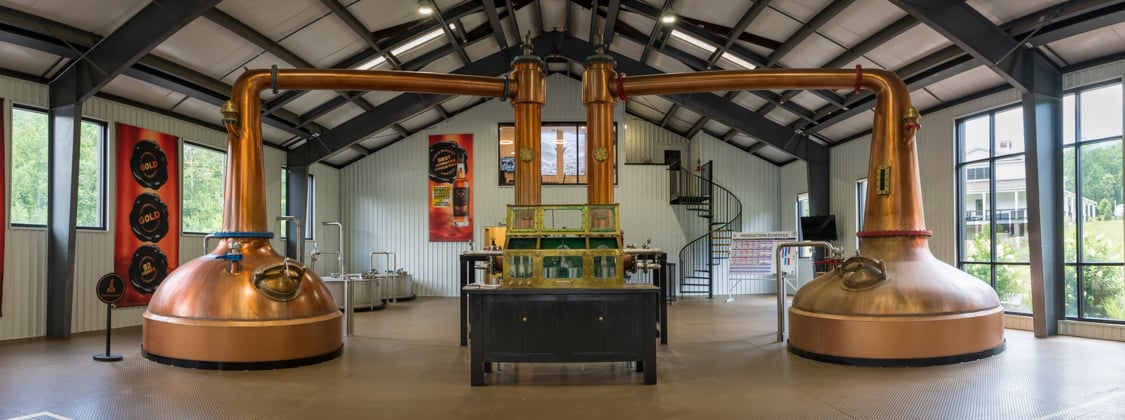
For the Dr. Jim Swan batch of Courage & Conviction, the malting, fermentation and distillation took place between February and October of 2016. The distillate produced between February and May was put into Bourbon casks, where the distillate produced between August and October of 2016 was put into both Cuvée and Sherry casks. These three cask types form the foundation of the Courage & Conviction line, our flagship American Single Malt whisky.
The data below are the averages of distillate-level data across each run for this second batch of Courage & Conviction. Learn more about the definitions of the metrics above in the glossary section at the bottom of this page.
| Milling & Fermentation Data |
|---|
| Total sample weight: 156 |
| Grist: 70% |
| Hulls: 21% |
| Flour: 9% |
| Original Gravity: 1.051 |
| Final Gravity: 0.995 |
| Attenuation: 102.6% |
| % ABV: 7.2% |
SPIRIT ANALYSIS
Throughout the year, we send samples of our barley spirit off for third party analysis. The data below was pulled from samples distilled at the same time as selections for our second batch of Courage & Conviction. Although the maturation and cask selection process gets credit for many of our whisky's flavors and aromas, many delicious and complex notes originate from esters and congeners developed during fermentation that are further focused through the distillation process. These data points allow us to predict notes as distinct as green apple (Acetaldehyde), pear drops (Ethyl-acetate) and banana (Isoamyl-Acetate) in our whisky.

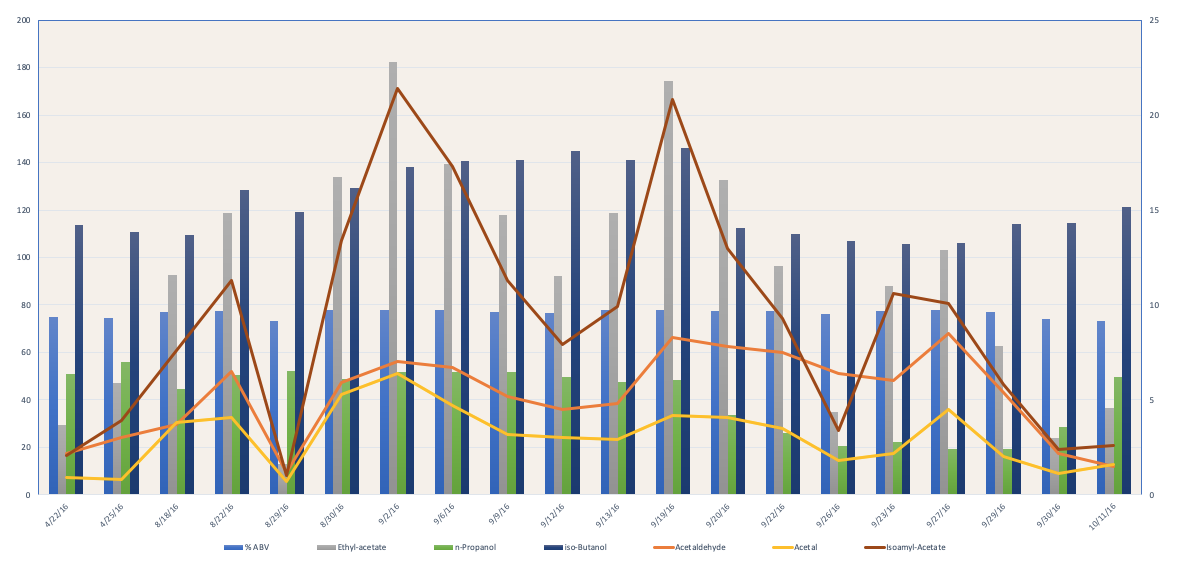
iNTO THE CASKS
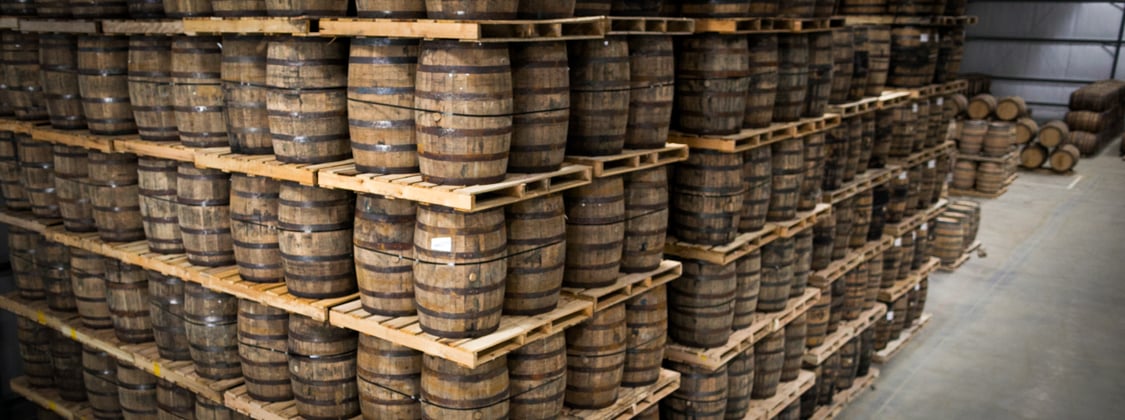
Developed under the tutelage of the late Dr. Jim Swan, Courage & Conviction was matured in a combination of Bourbon, Cuvée and Sherry casks. All the distillate created for this batch is exactly the same, meaning we don’t mill, mash, ferment, or distill any differently based on what cask the distillate will be placed into for maturation.
A total of 115 casks (65 Bourbon, 32 Cuvée, 18 Sherry) were used for the Dr. Jim Swan batch, accounting for a total of 11,500 liters, or 3,038 gallons of whisky.
BOURBON CASKS
Each of the 65 bourbon barrels used in this batch once held Kentucky bourbon from well-known distilleries. These American oak barrels are 200 liters (52.8 gallons), and add notes of vanilla, caramel, butterscotch, oak, smoke and cinnamon to the final product.
Bourbon Casks: The fill dates were between 2/21/16 and 5/6/16, where the dump date was 5/28/2020. The age of the whisky from the bourbon barrels is between 4 years and 4 years 3 months based on the fill and dump dates.
CUVÉE CASKS
Each of the 32 Cuvée casks used in this batch are sourced from premium European red wine producers. After the wine is removed, the cask is broken down, the interior shaved, re-toasted and re-charred, and reassembled. The re-toasting and re-charring of the cask energizes the wood sugars and brings forward barrel spice, bright red fruit and toasted pecan. These casks are 225 liters (59.4 gallons). We are one of a handful of distilleries in the world to use this cask type, created by our mentor, Dr. Jim Swan.
Cuvée Casks: The fill dates were between 8/31/16 and 10/12/16, where the dump date was 5/28/2020. The age of the whisky from the Cuvée casks is 3 years and 7-8 months based on the fill and dump dates. When the barrels were delivered to us in 2016, they almost appeared brand new: they had been re-coopered, pressure tested, and shrink wrapped.
SHERRY CASKS
18 Sherry cask types were used for this batch (6 Fino, 6 Oloroso and 6 Pedro Ximénez). These casks give the whisky unique characteristics, including notes of tart cherry, golden raisin, fig, caramelized plum, brown sugar and spice. Both the Oloroso and Pedro Ximénez casks are 500 L (132.1 gallons) where the Fino casks are 512 L (135.3 gallons).
Sherry Casks: The fill dates were 8/3/16 and 9/28/16, where the dump date was 6/15/2020. The age of the whisky from the Sherry casks is 3 years and 9-10 months based on the fill and dump dates.
MATURATION
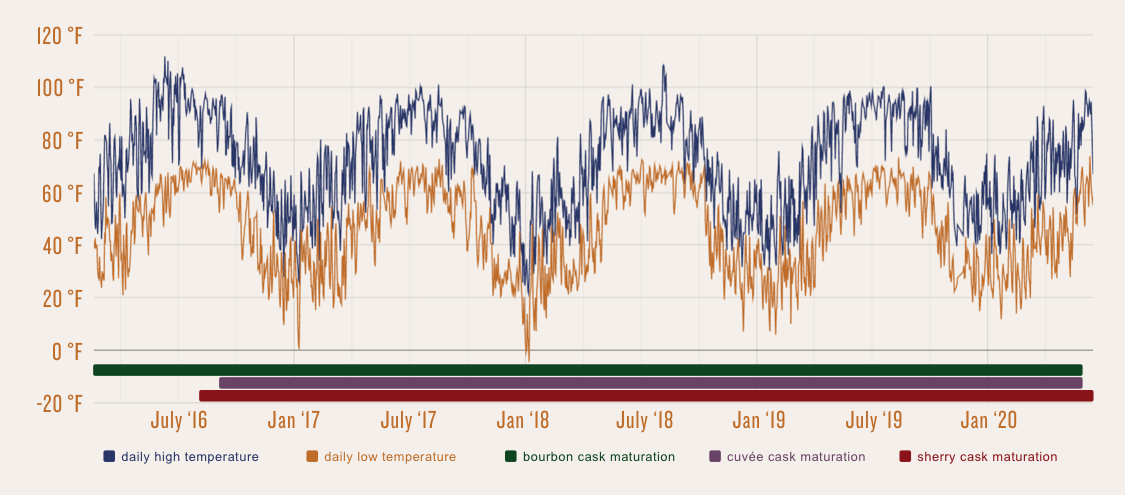
At our Lovingston, Virginia distillery, we see hot summers and cool winters. This is good for our whisky, as the casks will contract during cooler periods and expand during the heat of the summer. This contraction and expansion allows for more interaction between the spirit and the cask, resulting in a greater depth of flavor.
Compared to other regions of the world such as Scotland, our whiskies age faster due to the intensity of the expansion and contraction cycles. What occurs seasonally in the Old World can occur at a daily, even hourly rate here in Virginia. The upside to this is a whisky that naturally develops into a complex spirit with layers of aroma, flavor and depth at a far quicker pace than the aging time required for an Old World whisky. The downside for us is the rate of evaporation, or “Angel’s Share.” The more interaction between barrel stave and spirit, the more evaporation. Loss from a single year of aging in Scotland or Ireland averages around 1% annually. Here at Virginia Distillery Company we have seen an evaporation rate of 6-12% a year, proving once again that there is truth to the proverb “Age is just a number.”
Interestingly, both water and alcohol evaporate from the barrels, thus concentrating either or both elements, often to different degrees depending on heat and humidity factors. Virginia has significant humidity at times, so we’ve placed sensors among our barrels to track humidity and evaporation rates. In fact, the entry proof of our barrels may increase or decrease depending on a barrel’s location and the climate’s impacts.
TEMPERATURE DATA
The above graph shows the temperature swings during the time the whisky was maturing in our cask house between February 2016 and June 2020. The blue line shows daily high temperatures, where the copper line shows daily low temperatures.
In the 4+ years the whisky was maturing in our cask houses, Lovingston, Virginia had a total of 144 summer days where the outdoor temperature reached at least 95 degrees °F. The hottest day was on June 11, 2016, where the temperature reached a scorching 111.9 °F. During that same timeframe, we saw 79 nights where temperatures dipped below 20 °F. The coldest night was on January 7th, 2018, where the temperature dove down to a chilling -4.5 °F.
FILL / DUMP DATES
Bourbon Casks:The fill dates were between 2/21/16 and 5/6/16, where the dump date was 5/28/2020.
Cuvée Casks: The fill dates were between 8/31/16 and 10/12/16, where the dump date was 5/28/2020.
Sherry Casks: The fill dates were 8/3/16 and 9/28/16, where the dump date was 6/15/2020.
INTO THE BOTTLES

The final ratio of what goes into each bottle of Courage & Conviction is approximately from 50% Bourbon casks, 25% Cuvée casks, and 25% Sherry casks. We pulled additional volume of specific casks to hold a percentage back to incorporate into our next batch. This allows us to remain consistent from batch-to-batch while still allowing the nuance of each batch to show through based on specific barrel picks.
BOTTLING DATES
Bottling for the second batch took place between July and August 2020. The Dr. Jim Swan Batch of Courage & Conviction produced 1,650 cases of 750mL bottles, or 9,900 bottles.
Bottling for the second batch is also producing 1,500+ cases of 50mL bottles that will be available for sale in select stores across the country, as well as promotional items in select markets.
The remainder dumped whisky from the 115 casks will be used to transition to our third batch of Courage & Conviction for consistency.
SENSORY NOTES
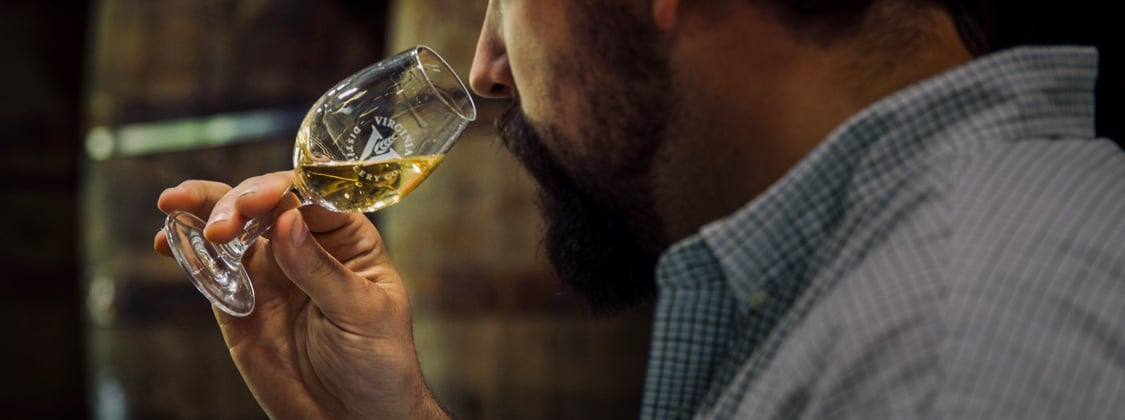
The flagship offering of Courage & Conviction will see a primary profile across all batches due to the specific types of casks. In addition, the ratio of those casks in our recipe is also the same from batch to batch. On the nose, you'll expect to find notes of caramel and butterscotch. On the palate, you’ll see bright red fruit, raspberry, cocoa, barrel spice and vanilla.
Based on the nuances of the individual barrel picks that go into each bottling, you should expect to see variation with each batch. Below are specific notes for the Dr. Jim Swan batch.
NOSE
The nose has aromas of honeyed apricots, blood orange, milk chocolate, vanilla custard and red berries that mingle with butterscotch and toasted pecans.
PALATE
The silky body brings flavors of grilled peaches merging into caramel, ginger and nutmeg.
FINISH
The finish builds into cinnamon and mouth-watering orange zest.
GLOSSARY

Below we’ve included some terms relating to our distillation and maturation processes that were used in the sections above.
DEFINITIONS
Total sample weight - This is in reference to the grist sample that is taken at the point of milling our malt into a grist for mashing. Preferably, we’d like to see our grist components from the milling process as follows: 20% hulls, 10% flour, and 70% grist. This ratio allows for optimal conversion of starches to sugars throughout the mashing process. The sample weight is the weight of a sample of grist from the mill during the milling process that we use to extract the component percentages.
Hulls - Coarsely milled grain also referred to as husks
Flour - Fine, powdery milled grain
Grist - Milled grain comprised of consistency somewhere between the consistency of hulls and flour, also known as heart or middles
Original Gravity - A measure of the fermentable and non-fermentable substances in wort before fermentation. Those substances are often the sugars that will be converted to alcohol during the fermentation process.
Final Gravity - The specific gravity measured at the completion of fermentation and represents the amount of unfermentable sugars remaining
Attenuation - The conversion of sugars into alcohol and carbon dioxide by the fermentation process; the greater the attenuation, the more sugar has been converted into alcohol
ABV - Alcohol By Volume, a standard measure of how much alcohol is contained in a given volume of an alcoholic beverage
Time Steam On - This is in reference to when we charge our stills and begin applying steam for distillation. As soon as the stills are charged (or filled), we initiate steam to begin the distillation process and record that entry.
Time Spirit in Safe - There is a lag phase from when steam is applied to the stills until distillate reaches the safe, as it takes a while for solutions to come to a boil. The time spirit in safe records entries at the moment distillate is realized as it flows into the safe.
Steam Off - This is in reference to both the wash and spirit stills and shows the exact time at which the stills reach the end of their runs and when the steam was turned off to the respective still.
Time On Spirit - Specific to the spirit still, the wash still only produces low wines, which is not quite at a quality or strength the be aged in a barrel, but the spirit still produces whisky that is, at very specific points during the distillation process, of high quality and strength that is appropriate for aging in barrels. Once the Foreshots (Non-High-Quality Distillate A.K.A Heads/High-Boilers) are distilled through, our distillers are checking to see the ABV is peaking (typically around 77% to 78% ABV, or, 154 to 156 proof) and that our aroma and flavor profile is present in the new make whisky through a brief nosing and tasting, and if the distillate meets the criteria, the distillers make the ‘cut’ to on-spirit. It’s at this point where our distillate is then collected separately from our low wines distillate, as new make whisky that will be proofed down and then filled into barrels.
Time Off Spirit - Specific to the spirit still and is the point at which our distillers see the ABV of the distillate from the spirit still drop to 70%, where we make a cut to off-spirit, where distillate is collected back into our low wines tank.
Fill Date - The date when the barrels or casks was filled with distilled spirit and prepared for maturation.
Original PG - Original proof gallons, the unit of measurement we use when gauging both the volume and the strength together within a solution of alcohol. The formal definition is 1 Proof Gallon = 0.5 Gallons of Pure Alcohol (100% ABV, or 200 Proof). Original PGs would have been the proof gallons that were originally filled into a barrel for aging.
Entry Proof - Whisky is filled into barrels for aging at various strengths or proofs. This is a measurement of the concentration of the alcohol. Regulations state that whisky cannot be filled into barrels at a strength no greater than 125 proof (or 62.5% Alcohol by Volume). Proof is a unit of concentration similar to a percentage but it’s specifically in relation to proof gallons.
Cooperage WG - Cooperage refers to a barrel, and WG refers to wine gallons, a term used in distilling and brewing for a standard gallon.
Dump Date - The date when the whisky completed maturation and was removed from the barrel or cask.
Dumped PG - The proof gallons that were dumped from a barrel after it has aged. These are the recovered proof gallons, which will ultimately be less than the original proof gallons.
Losses (PG) - The losses realized at the point of gauging the dumped barrel’s proof gallons in comparison to the original proof gallons the barrels held. Otherwise known as the angel’s share measured in proof gallons.
Losses (%) - These are the losses in proof gallons displayed as a percentage rather than a volume. Otherwise known as the angel’s share measured as a percentage.
